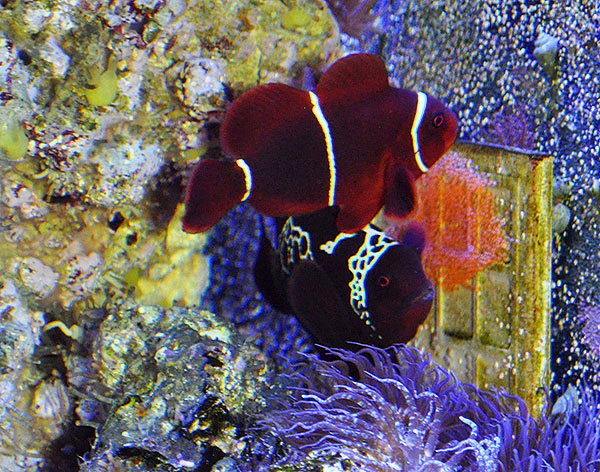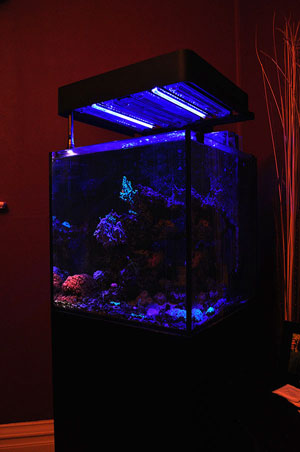Filed under Aqua Blue, Coral Magazine Article by Tim
LIGHTNING MAROON CLOWNFISH SPAWNS
First successful hatch after months of frustration

Dubbed the Lightning Maroon Clownfish, the aberrant markings may or may not be a genetically transmitted trait. Both members of the pair were collected in the same area of Papua New Guinea. They were coaxed into this first viable spawn by breeder Matt Pedersen in Duluth, Minnesota. The pair are housed in a 30-gallon cube reef aquarium, below.
STAFF REPORT: It has been two long years since an electrifyingly pigmented Maroon Clownfish, Premnas biaculeatus, was collected in Papua New Guinea and exported to the United States. This emblematic clownfish, the only known living specimen and the second of two aberrant Maroon Clownfish collected in Papua New Guinea in the last few years, has captured the hearts and minds of aquarists around the world (see CORAL, July/August 2011). Matt Pedersen, a breeder in Duluth, Minnesota, has been on a quest to get the fish, a female, to spawn but has admitted to many frustrations via his Lightning Project blog.
 “In the past few months The Lightning Project has gone from relatively boring stability to dramatic highs and lows,” he says. Pedersen has been battling ongoing chronic maladies in the broodstock pair, having gone as far as to enlist a fish veterinarian to collaborate in troubleshooting this problem. Finally, however, Pedersen reports having succeeded in coaxing the Lightning Maroon and her mate to produce a healthy clutch of eggs after months of fruitless nesting behaviors. Pedersen says he used a technique referred to as a “double down,” first shared with him by fellow marine fish breeder Mitch “Booyah” May. By placing a spawning tile with eggs from another clownfish pair, a breeder can sometimes stimulate a reluctant pair to produce their own eggs. The Lightning Maroon pair was successfuly enticed into their first small spawn, which was quickly eaten. Extreme disappointment settled in among all aquarists who are following this drama.
In the past two weeks, the Lightning Maroon and her mate have spawned for a second time, this time with an estimated 310 fertile eggs which they did not consume. “Of course, they’ve continued to throw every trick in the book at me,”says Pedersen. “First, more disease problems surfaced during the incubation of the spawn. No sooner was that problem handled, then it was followed by the early hatching of a single larva. This early hatch could have put the rest of the clutch in jeopardy during what could have been a risky, if not disastrous, artificial incubation and hatch.”
As of July 5th, 2012, Pedersen has reached yet another milestone in the breeding project, introducing APBreed TDO, a larviculture feed, as the Lightning Maroon’s offspring near the next critical and risky step in their development: metamorphosis and settlement.
“It is at settlement when Maroon clownfish first reveal their stripes; it may become known if the ‘lightning trait has appeared in this first generation of offspring,” says Pedersen, a CORAL senior editor. “While it may or may not be immediately apparent, the first possible glimmer may be only days away.”
|
|
|
Tags:
aqua blue distribution,
Coral Magazine
July 9, 2012 - 7:42 AM